|
The Standard Poodle is an elegant, medium to large-sized
dog, with a profuse, but well groomed and clipped, wiry curly coat.
The Standard Poodle has a delightful springy gait. Height, Weight A long-lived breed, Poodles are, nevertheless,
subject to many genetic diseases. Cataracts and progressive retinal
atrophy may cause blindness, allergies and skin conditions are common...
possibly due to unskilled use of clippers or allergies to shampoo
and/or color reinforcer. Hip dysplasia, runny eyes, and ear infections
are also common. They are prone to PRA and Von Willebrand's Disease.
Brown Poodles tend to become prematurely gray. Prone to bloat, so
it is wise to feed your Standard 2-3 small meals a day, rather then
one large one. The three sizes are considered as one breed and are judged by the same standard. Today, the Poodle is primarily a companion and show dog, though he can learn almost anything.
The Bolognese is a typical small bichon dog, intelligent,
happy, faithful and companionable. While not hyperactive or high-strung,
they are vivacious and full of fun. Breeders report that even ten-year-olds
still play like puppies. They are quite fearless and love people. Bred as companions, they need the attention and
presence of their family. In fact, they become so attached to their
owners they are like a shadow, following their idols from room to
room. "To have a Bolognese in the house is to have someone
to love and adore." The cottony white coat requires daily brushing to keep it free of tangles. But apart from coat care, they are healthy, quiet dogs that make superb companions. They have acute hearing and eyesight, taking notice of anything new or unusual and notify their owners. So, while not barkers, they can be true watchdogs.
The Havanese was soon a favorite of the very wealthy,
and a frequent sight in the palaces and country estates. Catalina
Laza, the wife of a wealthy Cuban sugar mill baron, raised the dogs
for her own pleasure and to present to society friends. When the
Cuban Revolution threatened the existence of these dogs and their
owners, they were smuggled out by families fleeing their homeland.
Quite rare today, they are now being revived and promoted by fanciers
in the USA who have formed the Havanese Club of America. Temperament for this breed is similar to all its
bichon cousins—charming, intelligent and alert. Adults can
be aloof with strangers. The Havanese has been known to guard children
heroically and is a loving and devoted companion. Natural clowns,
they are superb circus and trick dogs. Like the Bolognese, they
make good watchdogs because of their alert demeanor and close relationship
with their owners. One owner says they are "fantastic little
friends." Their sturdiness and longevity make extra pluses
as companions and their brilliance of colors, including cream, gold,
silver, blue, black, chocolate (appropriately called "tobacco
brown"), the rare white, or combinations of these adds to their
appeal. Modern show dogs are kept free of tangles, but any trimming
is prohibited. This breed is devoted to its masters, wanting
always to be in their presence and trying its best to please. Because
of these traits, the Coton requires little in the way of discipline
to create a fine companion. He is a dog only for a house pet, as
he is so happy and friendly that he will not defend himself. Like
the other bichon dogs, however, he is alert and intelligent and
will inform his master of unusual events. As long as he is primarily
a house dog, he adapts well to almost any environment or climate.
The breed is healthy and vigorous despite its small size, and requires
only a bit of regular brushing to keep it handsome. One of their
most endearing traits is a tendency to jump and walk on their hind
legs. Like the other bichons, the hair needs regular grooming to keep the dogs looking their cuddly best. Shedding on all the bichons is minimal and an advantage to allergic owners. The Coton's expression is ''enquiring and adoring." |
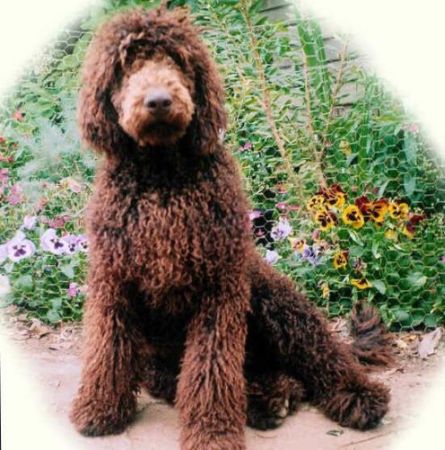
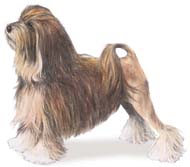 Lowchen
(The Little Lion dog) is purely a pet dog and is suitable for old
people or families with children. It's an extremely people-oriented
dog. If it has to choose between humans and dogs, it might well
choose its human family. The Lowchen loves everyone, but will usually
pick a favorite family member. If you choose a Lowchen you will
have a faithful, charming, fun friend through thick and thin. It's
a friend for that will stay for a long time. The breed has no breed
specific health problems and is long lived. Most Lowchens live for
12-15 years or more. Lowchen was named after the 'hairdo'. It is
believed that the breed has its roots in early medieval times, in
the Mediterranean area.
Lowchen
(The Little Lion dog) is purely a pet dog and is suitable for old
people or families with children. It's an extremely people-oriented
dog. If it has to choose between humans and dogs, it might well
choose its human family. The Lowchen loves everyone, but will usually
pick a favorite family member. If you choose a Lowchen you will
have a faithful, charming, fun friend through thick and thin. It's
a friend for that will stay for a long time. The breed has no breed
specific health problems and is long lived. Most Lowchens live for
12-15 years or more. Lowchen was named after the 'hairdo'. It is
believed that the breed has its roots in early medieval times, in
the Mediterranean area. 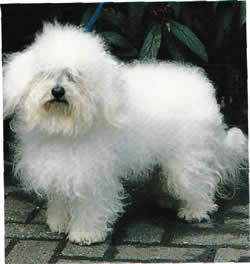 Bologna
is a city of northern Italy, well known for centuries as a center
of art and learning. The existence of the Bolognese has been recorded
since the year 1200, most probably descended from bichon types brought
in from southern Italy and Malta. By the Renaissance, the Bolognese
had become a favorite of the nobility. Both the Gonzagas and the
Medicis bred them and the Duke d'Este gave a pair to King Phillip
II of Spain. Supposedly, he indicated that he had never received
a better gift. This breed was also a favorite with La Pompadour,
Catherine of Russia, and the ladies-in-waiting of many European
courts. Today it is less known, in fact, almost rare in its homeland.
Bologna
is a city of northern Italy, well known for centuries as a center
of art and learning. The existence of the Bolognese has been recorded
since the year 1200, most probably descended from bichon types brought
in from southern Italy and Malta. By the Renaissance, the Bolognese
had become a favorite of the nobility. Both the Gonzagas and the
Medicis bred them and the Duke d'Este gave a pair to King Phillip
II of Spain. Supposedly, he indicated that he had never received
a better gift. This breed was also a favorite with La Pompadour,
Catherine of Russia, and the ladies-in-waiting of many European
courts. Today it is less known, in fact, almost rare in its homeland.
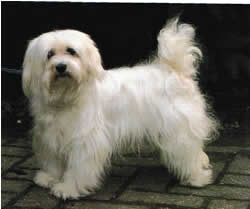 Bichon
Havanais/Havanese. These charmers descended from bichon types
of the Old World, but there is some argument about which specific
type was the origin. Most researchers say they came with the Spanish
as they colonized the West Indies, which would probably point to
Tenerife and the Bichon Frise as the progenitors. But Cubans seem
to feel the dog originally came to their island with Italian sea
captains, thus pointing to Malta or Bologna as the source. Captains
often carried illegal contraband to be sold to wealthy Cuban families.
"Hence, the entree gift of one of these precious little dogs
to the wealthy Sefioras [sic] opened the doors of her home to them."
Bichon
Havanais/Havanese. These charmers descended from bichon types
of the Old World, but there is some argument about which specific
type was the origin. Most researchers say they came with the Spanish
as they colonized the West Indies, which would probably point to
Tenerife and the Bichon Frise as the progenitors. But Cubans seem
to feel the dog originally came to their island with Italian sea
captains, thus pointing to Malta or Bologna as the source. Captains
often carried illegal contraband to be sold to wealthy Cuban families.
"Hence, the entree gift of one of these precious little dogs
to the wealthy Sefioras [sic] opened the doors of her home to them."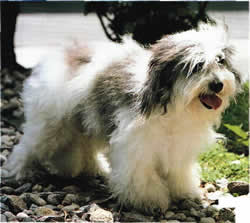 The
Coton de Tulear. Bichon dogs from Tenerife were brought to Madagascar
and nearby islands on trade ships, probably before the 17th century.
From these original imports came the Colon de Reunion, an extinct
breed once known on Reunion Island. The descendants of the Coton
de Reunion became established near the city of Tulear, Madagascar,
and developed into the breed known as the Coton de Tulear.
The
Coton de Tulear. Bichon dogs from Tenerife were brought to Madagascar
and nearby islands on trade ships, probably before the 17th century.
From these original imports came the Colon de Reunion, an extinct
breed once known on Reunion Island. The descendants of the Coton
de Reunion became established near the city of Tulear, Madagascar,
and developed into the breed known as the Coton de Tulear.